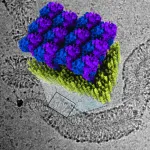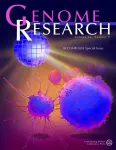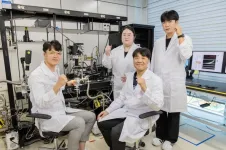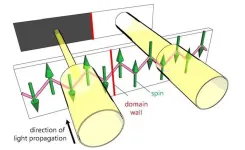(Press-News.org) Delft scientists discover how innate immunity envelops bacteria
The protein GBP1 is a vital component of our body’s natural defence against pathogens. This substance fights against bacteria and parasites by enveloping them in a protein coat, but how the substance manages to do this has remained unknown until now. Researchers from Delft University of Technology have now unravelled how this protein operates. This new knowledge, published in Nature Structural & Molecular Biology, could aid in the development of medications and therapies for individuals with weakened immune systems.
So-called Guanylate Binding Proteins (GBPs) play a crucial role in our innate immune system, explains biophysicist Arjen Jakobi: “GBPs form the first line of defence against various infectious diseases caused by bacteria and parasites. Examples of such diseases include dysentery, typhoid fever caused by Salmonella bacteria, and tuberculosis. The protein also plays a significant role in the sexually transmitted infection chlamydia as well as in toxoplasmosis, which is particularly dangerous during pregnancy and for unborn children.”
Coat around bacteria
In their publication, Jakobi and his colleagues describe for the first time how the innate immune system fights against bacteria using GBP1 proteins. “The protein surrounds bacteria by forming a sort of coat around them,” explains Tanja Kuhm, PhD candidate in Jakobi’s research group and the lead author of the article. “By pulling this coat tighter, it breaks the membrane of the bacteria—the protective layer surrounding the intruder—after which immune cells can clear the infection.”
Deciphering the defence strategy
To decode the defence strategy of GBPs, the researchers examined how GBP1 proteins bind to bacterial membranes using a cryogenic electron microscope. This allowed them to see the process in great detail down to the scale of molecules. Jakobi: “We were able to obtain a detailed three-dimensional image of how the protein coat forms. Together with biophysical experiments conducted in Sander Tans’ research group at research institute AMOLF, which enabled us to manipulate the system precisely, we succeeded in deciphering the mechanism of the antibacterial function.”
Medications
According to Jakobi, this research helps us understand better how our body is capable of combating bacterial infections. “If we can grasp this well, and we can specifically activate or deactivate the involved proteins through medication, it may offer opportunities to speed up getting rid of certain infections.”
END
Delft scientists discover how innate immunity envelops bacteria
2024-10-11
ELSE PRESS RELEASES FROM THIS DATE:
Workforce diversity is key to advancing One Health
2024-10-11
[Vienna, October 11, 2024] – A new article highlights a critical issue in the One Health approach—an emerging global framework for tackling complex health challenges at the intersection of human, animal, and environmental health. In the article in The Lancet Planetary Health, scientists Amélie Desvars-Larrive and Fariba Karimi from the Complexity Science Hub (CSH) point out that One Health's current framework fails to explicitly address workforce diversity.
According to Desvars-Larrive and Karimi, ...
Genome Research publishes a special issue on innovations in computational biology
2024-10-11
October 11, 2024 – Genome Research (https://genome.org) publishes a special issue highlighting novel advances in computational biology.
In collaboration with the International Conference on Research in Computational Molecular Biology (RECOMB), Genome Research publishes a collection of 20 computational methods and their applications in genomics including spatial, single-cell, and long-read sequencing. These include algorithmic innovations in genomic variation analysis, privacy-preserving algorithms, DNA structural properties, cancer genomics, ...
A quick and easy way to produce anode materials for sodium-ion batteries using microwaves
2024-10-11
The research team led by Dr. Daeho Kim and Dr. Jong Hwan Park at the Nano Hybrid Technology Research Center of the Korea Electrotechnology Research Institute (KERI) has developed a groundbreaking process technology that enables for ultrafast, 30-second preparation of hard carbon anodes for sodium-ion batteries using microwave induction heating.
One of the next-generation secondary batteries, the sodium-ion battery uses sodium (Na) in lieu of the current mainstay, lithium (Li). Sodium, the main component of salt, is more than a thousand times more abundant than lithium and is easier to extract and refine. Furthermore, its lower reactivity compared ...
‘Inside-out’ galaxy growth observed in the early universe
2024-10-11
Astronomers have used the NASA/ESA James Webb Space Telescope (JWST) to observe the ‘inside-out’ growth of a galaxy in the early universe, only 700 million years after the Big Bang.
This galaxy is one hundred times smaller than the Milky Way, but is surprisingly mature for so early in the universe. Like a large city, this galaxy has a dense collection of stars at its core but becomes less dense in the galactic ‘suburbs’. And like a large city, this galaxy is starting to sprawl, with star formation accelerating in the outskirts.
This is the earliest-ever detection of inside-out galactic growth. ...
Protein blocking bone development could hold clues for future osteoporosis treatment
2024-10-11
Scientists have identified a protein that blocks the activity of bone-forming cells (osteoblasts) by stopping them from maturing during the journey to sites of bone formation, a new study has found.
In a paper published in Communications Biology today (Friday 11 October 2024), a team of researchers led by Dr Amy Naylor and Professor Roy Bicknell along with their team including Dr Georgiana Neag from the University of Birmingham have found that protein CLEC14A, which is found on blood vessel cells called endothelial ...
A new method makes high-resolution imaging more accessible
2024-10-11
A classical way to image nanoscale structures in cells is with high-powered, expensive super-resolution microscopes. As an alternative, MIT researchers have developed a way to expand tissue before imaging it — a technique that allows them to achieve nanoscale resolution with a conventional light microscope.
In the newest version of this technique, the researchers have made it possible to expand tissue 20-fold in a single step. This simple, inexpensive method could pave the way for nearly any biology lab to perform nanoscale imaging.
“This democratizes imaging,” says Laura Kiessling, the Novartis Professor ...
Tiny magnetic discs offer remote brain stimulation without transgenes
2024-10-11
Novel magnetic nanodiscs could provide a much less invasive way of stimulating parts of the brain, paving the way for stimulation therapies without implants or genetic modification, MIT researchers report.
The scientists envision that the tiny discs, which are about 250 nanometers across (about 1/500 the width of a human hair), would be injected directly into the desired location in the brain. From there, they could be activated at any time simply by applying a magnetic field outside the body. The new particles could quickly find applications in biomedical research, and eventually, after sufficient testing, ...
Illuminating quantum magnets: Light unveils magnetic domains
2024-10-11
When something draws us in like a magnet, we take a closer look. When magnets draw in physicists, they take a quantum look.
Scientists from Osaka Metropolitan University and the University of Tokyo have successfully used light to visualize tiny magnetic regions, known as magnetic domains, in a specialized quantum material. Moreover, they successfully manipulated these regions by the application of an electric field. Their findings offer new insights into the complex behavior of magnetic materials at the quantum level, paving the way for future technological advances.
Most of us are familiar with magnets that stick to metal surfaces. But what about those that do not? Among ...
Different types of teenage friendships critical to wellbeing as we age, scientists find
2024-10-11
Being a teenager is hard, confusing — and crucially important. Scientists studying teenage socializing have found that teenaged friendships could lay essential foundations for wellbeing in later life, and that not just the kinds of friendships teenagers experience but the timing of those friendships is critical.
“A teen’s perception of how broadly socially accepted they are by their peers in early adolescence is particularly influential in predicting adult wellbeing,” said Emily Shah of the University of Arkansas, first author of the article in Frontiers in Developmental Psychology. “Conversely, in late adolescence, the quality of their more ...
Hawaii distillery project wins funding from Scottish brewing and distilling award
2024-10-11
Hawaii could soon be welcoming a new distillery after a postgraduate student at Scotland’s Heriot-Watt University won a prestigious entrepreneurial award.
Canadian student Ethan Wang, 42, wants to open a new distillery on Hawaii’s scenic volcanic island of Maui and said he was in “total shock” after winning cash and support from an industry membership organisation to help make his idea happen.
The award, called the Worshipful Company of Distillers’ Entrepreneurship Award, is designed to help students apply their science in the real world and is run jointly by Heriot-Watt’s respected International Centre for Brewing and Distilling and The Worshipful Company ...





